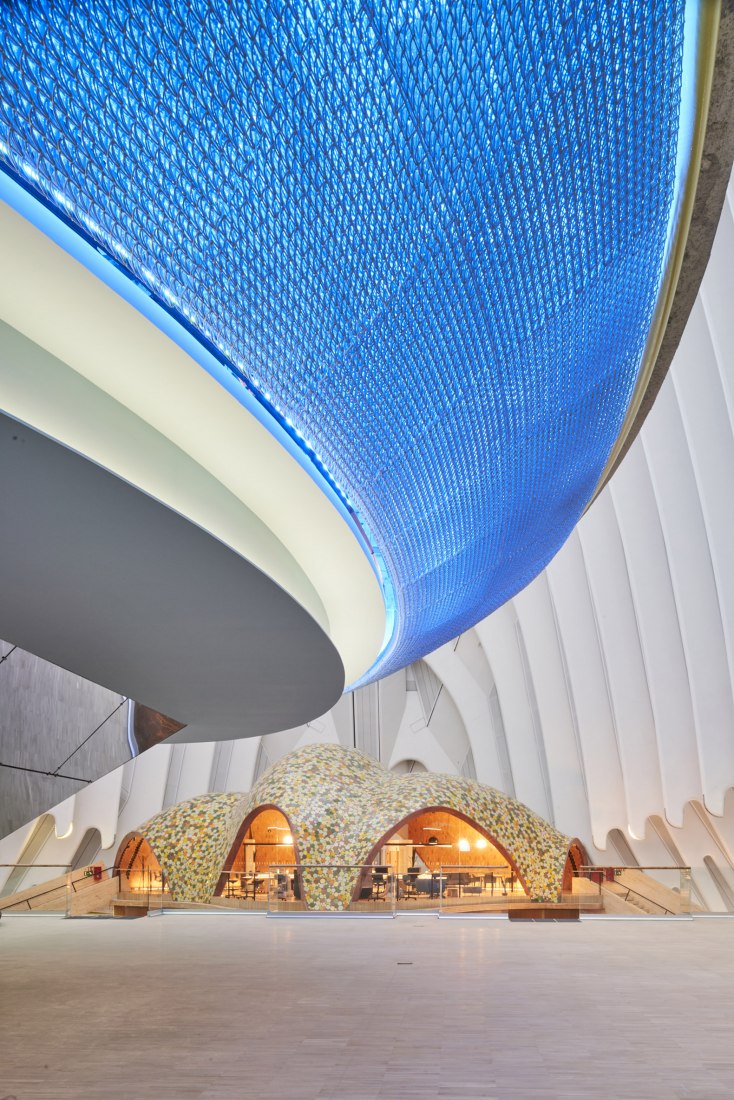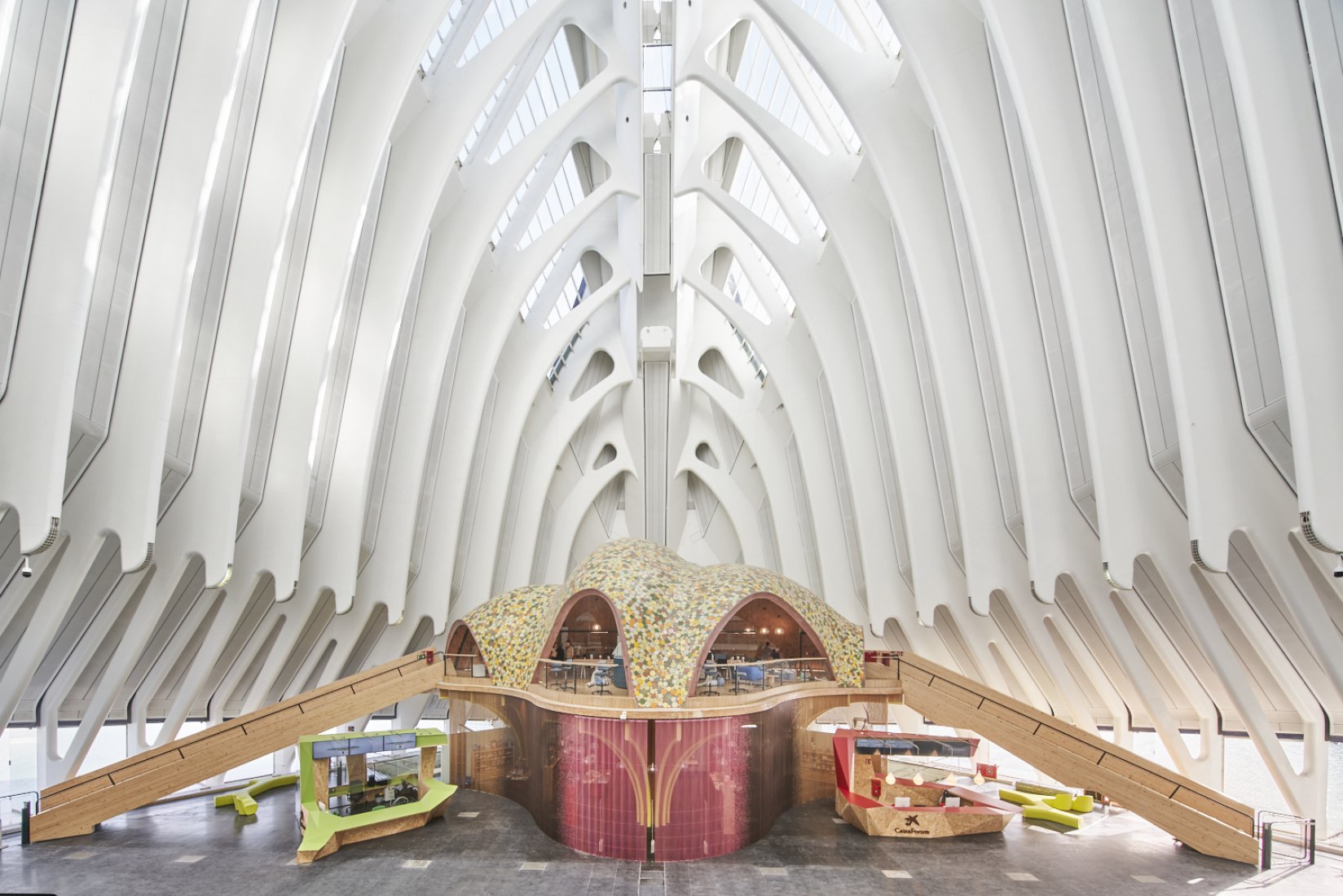Works on CaixaForum València began in 2018 inside the Ágora building, a large covered square designed by Santiago Calatrava located in the Ciutat de les Arts i les Ciències de València complex, between the Assut de l'Or bridge and the Oceanogràfic . The project is the work of the Cloud 9 studio, directed by the architect Enric Ruiz-Geli. The main characteristic of the project, according to its authors, is the enhancement of the concept of the Agora –understood as a surface open to dialogue and cultural activity–, as well as environmental sustainability.
The centre has a useful area of 6,500 square meters and has two large exhibition halls located on the ground floor. It also has multipurpose classrooms, an auditorium, family and educational spaces, a bookstore and a restaurant. The cultural offer is wide: from art exhibitions, conference cycles, concerts and shows, to social days and educational and family workshops aimed at all ages.
Far from being limited to functionality, CaixaForum València is itself an artistic creation: a landscape made up of different capsules and protected by the colossal shell of the building's structure, in which sustainability plays a key role. In this way, the architecture of the original building and the architectural intervention coexist in harmony to allow its cultural use, since the project respects, enhances and coexists with the building, maintaining its essence as a space for reflection and a large open, public and recreational cultural area. intense activity.

Inside CaixaForum Valencia. City of Arts and Sciences. Exterior of CaixaForum Valencia. Photography by Miguel Lorenzo / “la Caixa” Foundation.

Inside CaixaForum Valencia. City of Arts and Sciences. Exterior of CaixaForum Valencia. Photography by Miguel Lorenzo / “la Caixa” Foundation.
Program.
Enric Ruiz-Geli's project creates a world of living cells inside the building. The architect describes it as a landscape made up of interconnected spaces in a protective ecosystem.
La Nube, intended for family and educational activities, is the most distinctive element of CaixaForum València. It is built with very light materials: the floor is made of pure fiberglass, with a slight movement to achieve a subtle sensation of floating, of lack of gravity. The coating is made of very light and almost transparent polymers. The interior is diaphanous and multifunctional.
The Cloud is connected to the five oceans through real-time data. Depending on their temperature, the light changes from blue to violet. Blues tell us about the good health of the planet; the violets, climate change, rising water temperatures, and melting ice.
The two exhibition halls are tall, diaphanous, well-lit spaces with pioneering air conditioning. The lighting is done with an arch system so that a slight shadow is achieved that gives all the prominence to the works of art.
At one end of the building is the auditorium, equipment with the latest technology to host all kinds of shows. It has been conceived as a black box, with a cardboard landscape and an installation by Frederic Amat on the ceiling that calls for the protection of forests, entitled The Written Forest.
The restaurant occupies a privileged place on another side of the building and has a landscaped roof. It is a tall, huge cork cave, comfortable and without resonance, thanks to the acoustic absorbency of this material. A bright atmosphere is generated in this space thanks to the large skylights oriented to the four cardinal points to guarantee the reduction of energy consumption.
Another characteristic element of this CaixaForum is the space that houses the administration and the bookstore, with the roof covered by the ceramist Toni Cumella and supported by a wooden structure that learns from the palm trees of Elche.
La Nube, intended for family and educational activities, is the most distinctive element of CaixaForum València. It is built with very light materials: the floor is made of pure fiberglass, with a slight movement to achieve a subtle sensation of floating, of lack of gravity. The coating is made of very light and almost transparent polymers. The interior is diaphanous and multifunctional.
The Cloud is connected to the five oceans through real-time data. Depending on their temperature, the light changes from blue to violet. Blues tell us about the good health of the planet; the violets, climate change, rising water temperatures, and melting ice.
The two exhibition halls are tall, diaphanous, well-lit spaces with pioneering air conditioning. The lighting is done with an arch system so that a slight shadow is achieved that gives all the prominence to the works of art.
At one end of the building is the auditorium, equipment with the latest technology to host all kinds of shows. It has been conceived as a black box, with a cardboard landscape and an installation by Frederic Amat on the ceiling that calls for the protection of forests, entitled The Written Forest.
The restaurant occupies a privileged place on another side of the building and has a landscaped roof. It is a tall, huge cork cave, comfortable and without resonance, thanks to the acoustic absorbency of this material. A bright atmosphere is generated in this space thanks to the large skylights oriented to the four cardinal points to guarantee the reduction of energy consumption.
Another characteristic element of this CaixaForum is the space that houses the administration and the bookstore, with the roof covered by the ceramist Toni Cumella and supported by a wooden structure that learns from the palm trees of Elche.




















































